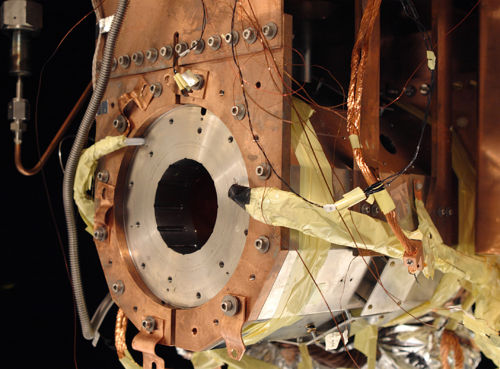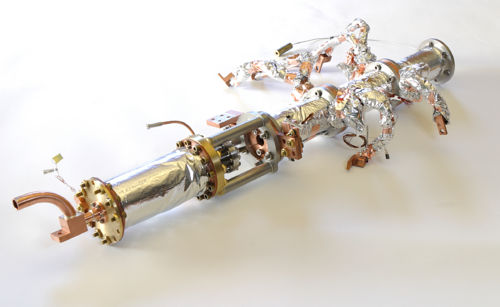Difference between revisions of "NH"
From DoyleGroup
(Created page with ' Resources page') |
|||
| Line 1: | Line 1: | ||
| − | [[NH:Resources| Resources | + | == About the NH experiment == |
| + | |||
| + | [[File:NH_magnet.jpg|thumb|500px|The NH trapping magnet]] | ||
| + | |||
| + | We cool nitrogen atoms and NH molecules to 500mK using helium vapor. The species fall into a 4T deep magnetic trap created by two superconducting coils in an anti-Helmholtz configuration. We study the collisions of the atoms and molecules with helium to elucidate spin relaxation mechanisms. The helium buffer gas can be extracted, to leave atoms and molecules thermally isolated from their environment. Future work will include studies of interatomic and intermolecular collisions and the development of techniques to increase the phase space densities of trapped species. | ||
| + | |||
| + | |||
| + | == Publications == | ||
| + | |||
| + | * Mechanism of Collisional Spin Relaxation in Triplet-Sigma Molecules, W.C. Campbell, T. V. Tscherbul, H.-I Lu, E. Tsikata, R. V. Krems, and J.M. Doyle. Phys Rev Lett 102, 013003 (2009). | ||
| + | * Time-Domain Measurement of Spontaneous Vibrational Decay of Magnetically Trapped NH, W.C. Campbell, G.C. Groenenboom, H. Lu, E. Tsikata, J.M. Doyle. Phys Rev Lett 100, 083003 (2008). | ||
| + | * Magnetic trapping of atomic nitrogen (^14N) and cotrapping of NH (X-triplet-Sigma-), M.T. Hummon, W.C. Campbell, H. Lu, E. Tsikata, Y. Wang, and J.M. Doyle, Phys Rev A 78, 050702(R) (2008). | ||
| + | * Magnetic Trapping and Zeeman Relaxation of NH (X-triplet-Sigma), W.C. Campbell, E. Tsikata, H. Lu, L.D. van Buuren, and J.M. Doyle. Phys Rev Lett 98, 213001 (2007). | ||
| + | * Buffer-gas cooling of NH via the beam loaded buffer-gas method, D. Egorov, W.C. Campbell, B. Friedrich, S.E. Maxwell, E. Tsikata, L.D. van Buuren, J.M. Doyle. Eur * Buffer-gas cooling of atomic and molecular beams. Dima Egorov, Thierry Lahaye, Wieland Schöllkopf, Bretislav Friedrich, and John M. Doyle. Phys Rev A 66, 043401 (2002) | ||
| + | |||
| + | == Resources == | ||
| + | [[File:NH bg reservoir.jpg|thumb|500px|The cryogenic fast-actuating valve used for introduction of He-3 buffer gas.]] | ||
| + | |||
| + | [[NH:Resources|Resources Page]] | ||
Revision as of 14:51, 19 July 2009
About the NH experiment
We cool nitrogen atoms and NH molecules to 500mK using helium vapor. The species fall into a 4T deep magnetic trap created by two superconducting coils in an anti-Helmholtz configuration. We study the collisions of the atoms and molecules with helium to elucidate spin relaxation mechanisms. The helium buffer gas can be extracted, to leave atoms and molecules thermally isolated from their environment. Future work will include studies of interatomic and intermolecular collisions and the development of techniques to increase the phase space densities of trapped species.
Publications
- Mechanism of Collisional Spin Relaxation in Triplet-Sigma Molecules, W.C. Campbell, T. V. Tscherbul, H.-I Lu, E. Tsikata, R. V. Krems, and J.M. Doyle. Phys Rev Lett 102, 013003 (2009).
- Time-Domain Measurement of Spontaneous Vibrational Decay of Magnetically Trapped NH, W.C. Campbell, G.C. Groenenboom, H. Lu, E. Tsikata, J.M. Doyle. Phys Rev Lett 100, 083003 (2008).
- Magnetic trapping of atomic nitrogen (^14N) and cotrapping of NH (X-triplet-Sigma-), M.T. Hummon, W.C. Campbell, H. Lu, E. Tsikata, Y. Wang, and J.M. Doyle, Phys Rev A 78, 050702(R) (2008).
- Magnetic Trapping and Zeeman Relaxation of NH (X-triplet-Sigma), W.C. Campbell, E. Tsikata, H. Lu, L.D. van Buuren, and J.M. Doyle. Phys Rev Lett 98, 213001 (2007).
- Buffer-gas cooling of NH via the beam loaded buffer-gas method, D. Egorov, W.C. Campbell, B. Friedrich, S.E. Maxwell, E. Tsikata, L.D. van Buuren, J.M. Doyle. Eur * Buffer-gas cooling of atomic and molecular beams. Dima Egorov, Thierry Lahaye, Wieland Schöllkopf, Bretislav Friedrich, and John M. Doyle. Phys Rev A 66, 043401 (2002)

